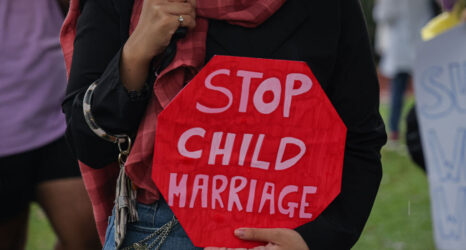As a former child athlete and now dedicated fan of women’s sports, I was riveted last month when Mo’Ne Davis pitched the Taney Dragons into Little League World Championship history (I was clearly not the only one; she now has more than 32,000 Twitter followers). Watching this 13-year-old girl demonstrate the confidence, poise and power that led The New York Times to call her “A Woman Among Boys” made me proud as hell that girls in our country have the opportunity to shine.
And while I recognize that Davis and her peers at her Philadelphia school still face many, many challenges on the road to true gender equality, I can’t help but think of the stark differences between these adolescent girls and those who face a far more dangerous fate across the world.
Fates like that of 13-year old Khadija, who escaped from the man she had been forced to marry, only to be returned to her Afghan village by police so that she could be brutally flogged for the
“crime” of running away from her husband.
Fates like those of the 14-year-old girl some of us at the International Center for Research on Women spoke with in northern Uganda, who was forced to drop out of school because her parents were no longer alive to pay her school fees, and who told us, “Now I know I will get married, give birth to children whom I cannot send to school because I will be poor. This is not what I wanted.”
Love the Ms. Blog? Join the Ms. community and support our fierce, feminist reporting!
Fates of the more than 70 million girls under the age of 18 who are currently married, and the 39,000 more who are being forced into marriage in countries across the developing world each and every day.
For far too long, adolescent girls and the unique challenges they face have been left out of conversations about global development. And despite research that shows how powerful a force girls can be in reducing poverty and inequality in their communities and around the world, development efforts have seldom included their points of view or sought to overcome the unique barriers that have held girls back.
Finally, the world is starting to pay attention.
In July, the UK government and UNICEF hosted a Girl Summit that highlighted the terrible practices of female genital mutilation/cutting and early, forced and child marriage. This week, the United Nations is meeting to discuss child marriage, its harmful impacts and what can be done to stop it. And later this month at the UN General Assembly, governments, UN agencies, advocates and many others will head to New York to define a global development agenda—known as the “Post-2015 Agenda”—that will guide the world for the next 15 years.
Early, forced and child marriage stem largely from poverty and from gross gender inequality, and result in significant negative consequences for girls, their communities and, ultimately, global development. Girls who are married early are less likely to complete school, with social norms in some countries dictating that married girls drop out of school in order to tend to chores at home. Early marriage contributes to early pregnancy, which is one of the leading causes of death among 15- to 19-year-old girls in the developing world. Married girls are at high risk of sexually transmitted infections (STIs), including HIV, and are more likely to experience violence, abuse and exploitation than those who marry later in life.
Child marriage is, fundamentally, a violation of girls’ basic human rights. When girls are married early, they’re often forced to have sex before they’re ready and with a partner they most likely did not choose. They’re taken away from their families, and expected to give up their education and their aspirations. They’re taken away from their friends, and, if they had previously been so fortunate as to play a sport, that is very likely no longer an option.
At the same time, we need to recognize that child marriage is also a significant impediment to reducing poverty and advancing global development. When otherwise brilliant, strong and influential girls are constrained to play the role of subservient, under-educated wife and young mother, they’re less likely to help their communities and powerless to contribute to their countries’ efforts to combat poverty.
This is why it is absolutely essential that the health, wellbeing and rights of adolescent girls be central to the Post-2015 Agenda. And it is even more essential that the perspectives of adolescent girls themselves be reflected in those conversations.
We can all contribute to this effort by endorsing the Girl Declaration and by sharing the voices of more than 500 girls living in poverty from 14 countries, which ICRW attempted to capture in a report called, “I Know. I Want. I Dream: Girls’ Insights for Building a Better World.”
Perhaps knowing that girls in Pakistan wish to “live freely like boys and not be restricted like girls;” that girls in Egypt want not to have anyone control them, hit them or tell them what clothes to wear; and that girls in Ethiopia “want everyone to realize that women are capable of doing everything” will help ensure that girls are not an afterthought in our future global development agenda.
Just like Mo’Ne Davis in Philadelphia, women and girls everywhere are capable of doing everything. But they can’t do it all unless we empower them, give them the tools to succeed and knock down the barriers that have held them back for far too long. Let’s make sure our global leaders get that message.
Photo courtesy of Flickr user emdot licensed under Creative Commons 2.0





